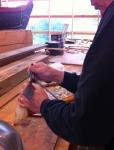WRANGELL, ALASKA
For the past week the Wrangell Carving Shed has been bustling with activity as locals of all ages learn to make traditional elbow adzes and begin to learn the basics of the craft.
“Actually we have been waiting for them to do something like this for years because there’s not a lot of a carver in town,” says local Shane Gillen. He and his sister Dacee Gillen are working on their first elbow adze tools. Dacee says this is a part of her culture she’s always wanted to learn more about.
“Because I’m native I’ve always wanted to know a little more about my heritage and the tools they used,” she says.
The Wrangell Cooperative Association teamed with Master Carvers Steve Brown and Wayne Price to organize the training with the goal of sharing their traditional craft, but also developing a local interest of adzing in the Wrangell community. They hope once classes are finished there will be a few locals who will be able to be a part of the carving team for the Chief Shakes Tribal House restoration project.
“We’re focusing on the adzes because of the importance of that toward the development of the shakes house project, and the development of the boards and the beams,”says Master Carver Steve Brown.
He says over the three days of sessions they have created over twenty adzing tools following the traditional methods.
“We’re taking basically found objects like leaf springs and tree branches, which is the way the old timer ones were made and were putting them together and creating a good cutting edge and an appropriate relationship between the angle of the blade and the angle of the handle. Overall we have had a good turnout of people who have created some good looking serviceable tools,” he says.
Over the week carvers have been working around the clock. One of those carvers is Justin Smith who is from White Horse in the Yukon Territory. He’s here as part of an apprenticeship to work on the Chief Shakes Tribal House. He’s been carving for 10-years and says there is a great deal of history to consider when approaching a project like this.
“You can see it on the walls of the clan house. There is a certain way they adze in a pattern. To me it looks like waves from the ocean, the way the pattern comes out. That’s how you can tell a really good adzer from a beginner,” he says.
Smith has been involved in a number carving projects from New Mexico to Alaska. And he says the preservation of cultures is something he’s passionate about and encourages all the beginning carvers to be patient. “You just got to do it, the more practice the better you get,” he says.
Master Carver Wayne Price says once the carving workshop is finished, intensive training will begin.
“We will see who holds out, who makes it. It’s not something you learn right away. It takes time, so people who come down and practice technique and keep their tools sharp, we will see who stands out,” he says.
The first phase of the project will be the daunting task of adzing nearly 7,000 sq ft of boards and beams for the restored tribal house, which Price says must to be completed before any further work can be done.
© Copyright, Wrangell Radio Group










